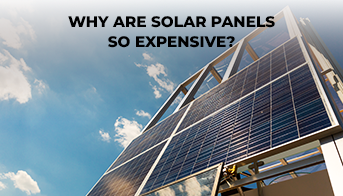


Solar panels have often been perceived as expensive, causing concerns for those interested in harnessing solar energy for their homes or businesses. The long-term value of photovoltaic panels outweighs their high initial price because of their wealth of advantages and benefits. So this blog, “US Energy Discounts” will explain why solar panels are so expensive.
Despite their initial expense, photovoltaic panels offer a cost-effective solution for generating electricity. The expense of a high-level panel installation can be likened to purchasing a new car. According to a report by photovoltaic energy associates, the average expense of a residential solar panel system ranges from $10,000 to $30,000, with an average installation expense of around $18,000. Although this may appear expensive, it’s crucial to think about the savings and long-term advantages.
The production of photovoltaic panels involves various materials and complex processes. Silicon, a key component of solar modules, requires refining and preparation before it can be utilized effectively. This refining process adds to the overall price of the panels. Additionally, a photovoltaic system is more than just a panel itself. To convert the produced power into a usable form, additional components are needed, such as inverters and off-grid systems with high-quality batteries.

When evaluating the price of a photovoltaic panel system, it is important to consider the following:
The expense of hardware alone accounts for around 46% of the average price of photovoltaic panels. The hardware includes the following:
The soft cost alone accounts for around 54% of the price of photovoltaic panels. It includes the following:
Yes, modules for solar energy will likely continue to get cheaper in the future. As a result of technological improvements, economies of scale, and greater competition in the energy business, the price of photovoltaic modules has been continuously falling over the past ten years. As more countries and individuals adopt energy from the sun, there is a growing demand for photovoltaic modules, leading to increased production and lower manufacturing expenses. Additionally, attempts are being made to increase the effectiveness and price of panels via continuing research and development.
Government policies and incentives, such as tax credits and subsidies, also play a significant role in driving down the expense of photovoltaic modules. These initiatives aim to promote renewable energy adoption and stimulate market growth, further contributing to cost reductions.
As the industry matures and becomes more established, we can expect continued innovation and efficiency gains, resulting in lower prices. This trend toward affordability will make thermal energy even more accessible and appealing to a wider range of consumers, ultimately accelerating the transition to clean and sustainable commercial & residential energy.

Furthermore, the choice of the company can also influence the final price of a photovoltaic panel system. Different companies often provide various incentives to attract customers, which directly impact the overall price. It is essential to consider these factors and compare offerings from different companies to find the best value for your investment.
While the price of panels may seem high, it is important to weigh these expenses against the long-term benefits, savings, and environmental benefits solar energy provides in 2023. As technology advances and economies of scale come into play, the expense of Photovoltaic modules is expected to decrease over time, making them more accessible to a wider audience.
Discount Power was established in 2005 by Jack Lee and Adriana. Company is professionally focusing on commercial energy and residential energy in deregulatory States of the US.